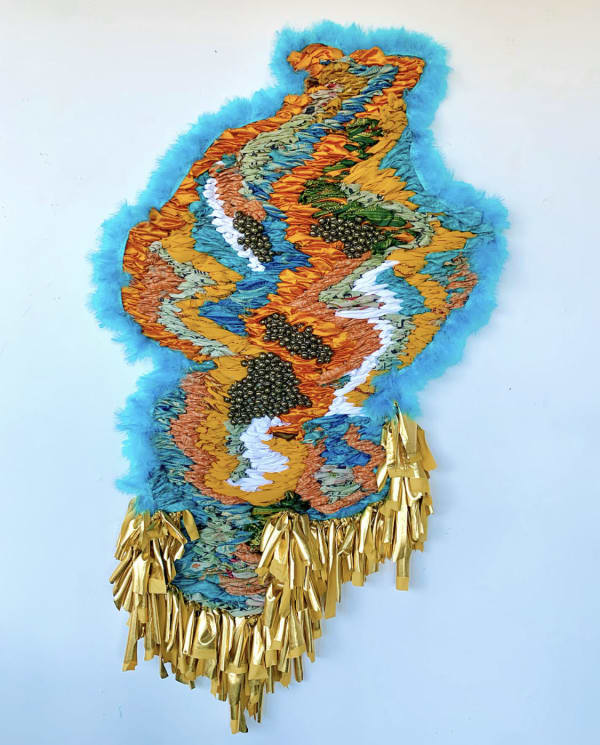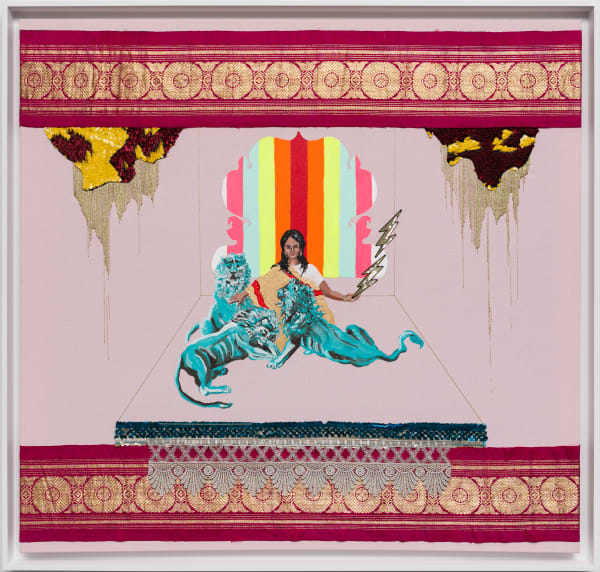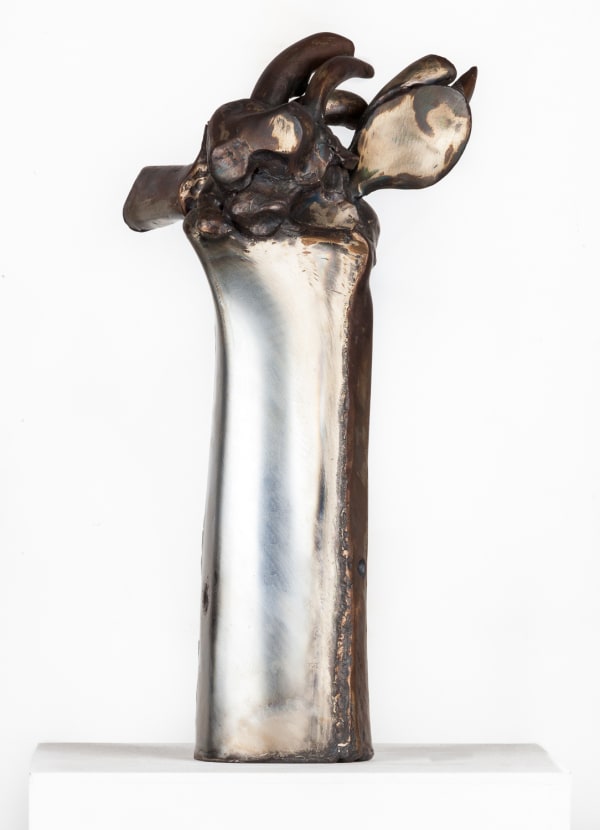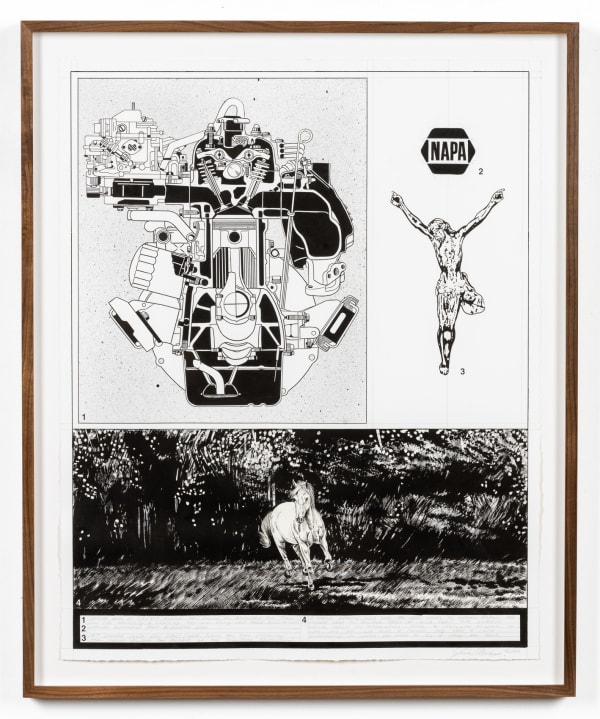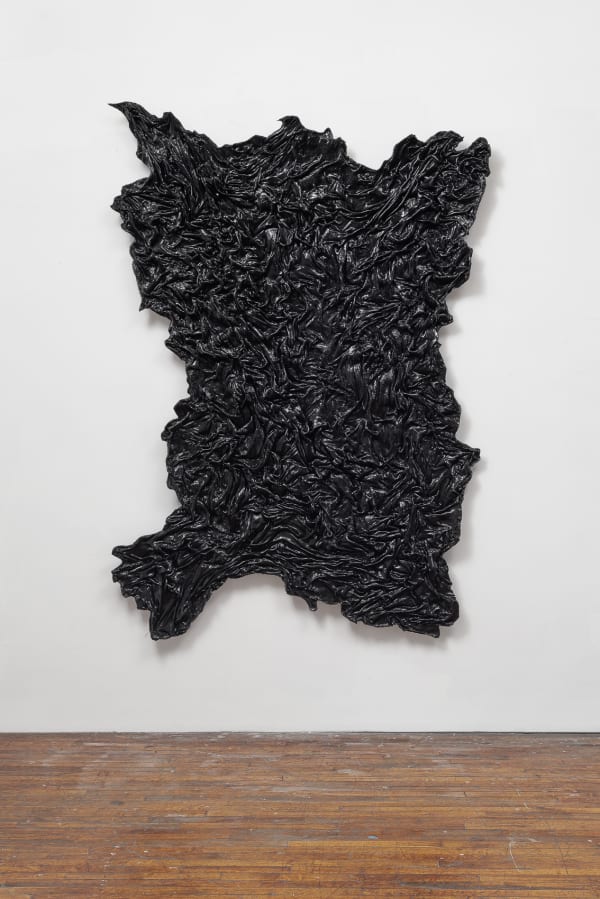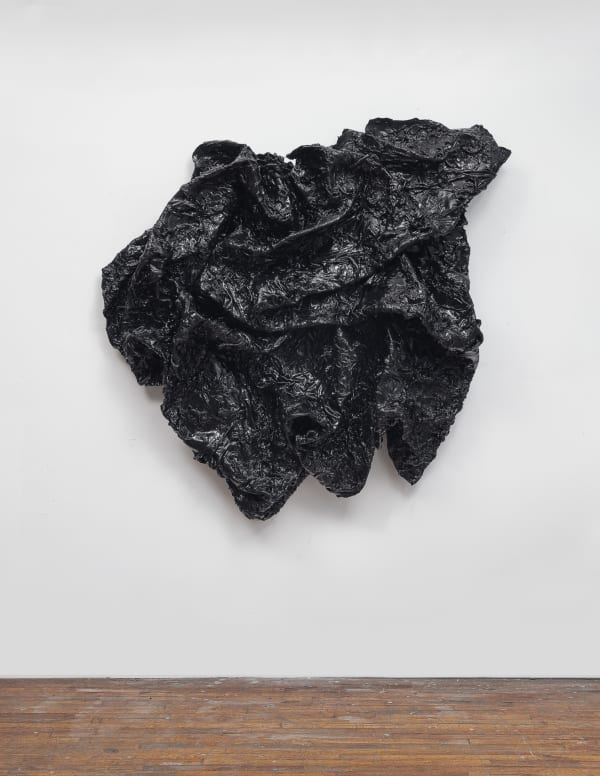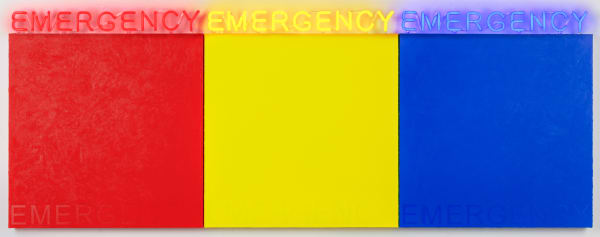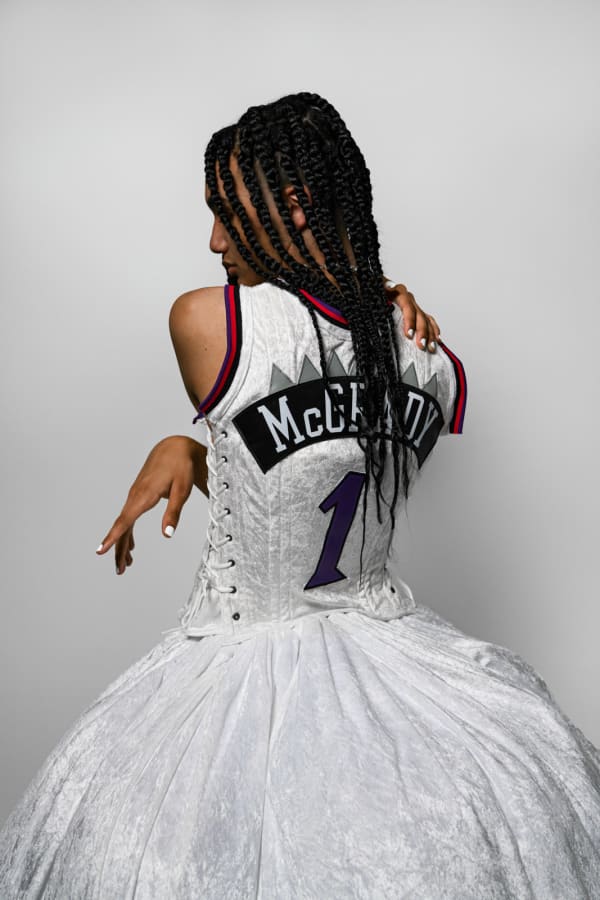-
It is with great excitement that Kavi Gupta celebrates the return of EXPO Chicago. After almost three years, we are once again able to spotlight our home city as the essential global locus for international contemporary art that it has always been. Our presentation at this year’s fair is a definitive representation of the enduring importance of Kavi Gupta’s ongoing mission to amplify voices of diverse and underrepresented artists to expand the canon of art history.
At this crucial moment, we are grateful for the chance EXPO Chicago gives us to center important works by some of the most influential, dynamic artists working today—including 2022 Whitney Biennial artist James Little! With five of his large-scale paintings on view in the biennial, Little is poised to finally achieve the recognition he has long deserved as an American master in the field of abstraction. We are also proud to exhibit major works by Devan Shimoyama, Beverly Fishman, and Alisa Sikelianos-Carter in conjunction with these artists’ ambitious solo exhibitions opening in our Chicago galleries during EXPO week; as well as exhibiting for the first time at EXPO the work of multiple artists who reflect our expanding, diverse program: including a new large-scale wall sculpture by Allana Clarke, made through a performative process of the artist physically wrestling with 30-second hair bonding glue; a new wall hanging from Suchitra Mattai, woven from vintage saris, ghungroo bells, boas, and other materials relating to the artist’s personal relationship to her Indo-Caribbean heritage; and the latest work by digital activist art collective Rewind Collective. We will also be spotlighting major works by Miya Ando; Alfred Conteh; Inka Essenhigh; Deborah Kass; Michi Meko; Jaime Muñoz; Manish Nai; Kour Pour; Mary Sibande; Jessica Stockholder; Su Su; along with guaranteed surprises from all of the artists in our program.
-
-

-

-
While developing his distinctive position within contemporary abstraction, Little (b. 1952, USA) has devoted decades to rigorous academic study of color theory, pictorial design, and painting techniques. His aesthetic language is rooted in simplicity, centering geometric shapes and patterns, flat surfaces, and emotive color relationships. In an age that frequently trades durability for ephemerality and mastery for instant gratification, Little might be seen as an outlier—a careful, precise, disciplined perfectionist who seeks personal improvement over fame and outside recognition. Yet, it is by embodying these rare values that Little can rightly be called the most important painter in America today. The restraint of his pictures belies the startling complexity of their making—Little makes his own binders and grinds his own pigments, and paints a majority of his works using what is the most complex and difficult-to-master method ever devised: blending handmade pigments with hot beeswax, similar to the encaustic painting technique developed by ancient Egyptian and Greek artists. In his studio/laboratory, Little hand manufactures this difficult medium, which is proven, under the right circumstances, to never wear down with age. Properly cared for, his wax paintings will look as vibrant and luminous a thousand years from now as they do today.
-
Little is a 2009 recipient of the Joan Mitchel Foundation Award for Painting. In addition to being featured prominently in the 2022 Whitney Biennial at the Whitney Museum of American Art in New York, NY, his work has been exhibited extensively in solo and group exhibitions around the world, including at MoMA P.S.1, New York, NY; Crystal Bridges Museum of American Art, Bentonville, AR; Studio Museum in Harlem, New York, NY; St. Louis Art Museum, St. Louis, MO; and the Smithsonian Institute, Washington, DC. Upcoming solo exhibitions include Homecoming: Bittersweet, at Dixon Gallery & Gardens: Art Museum, Memphis, TN, with an accompanying catalogue, and at Kavi Gupta, Chicago, IL, in 2022. In 2022, Little will also participate in a historic collaboration for Duke Ellington's conceptual Sacred Concerts series at the Lincoln Center, New York, NY, with the New York Choral Society at the New School for Social Research and the Schomburg Center in New York, NY. His paintings are represented in the collections of numerous public and private collections, including the Virginia Museum of Fine Art, Richmond; Studio Museum in Harlem, New York; DeMenil Collection in Houston; Library of Congress, Washington, DC; Maatschappij Arti Et Amicitiae, Amsterdam, Holland; Saint Louis Art Museum, Saint Louis; Everson Museum of Art, Syracuse; New Jersey State Museum, Trenton; Tennessee State Museum, Nashville; Arkansas Arts Center, Little Rock; and Newark Museum, Newark.
-
-

-
Devan Shimoyama’s work explores depictions of the Black, queer, male body within the context of personal and social transformation. Shimoyama has stated that he wants the figures in his work are perceived as "both desirable and desirous." He is aware of the politics of queer culture, and the ways in which those politics relate to black American culture. These elements come together in his works in a way that is both celebratory and complicated. The celebratory aspects of Shimoyama's work come through in his choice of materials. Employing such things as fur, feathers, glitter and costume jewels like rhinestones, and sequins, he brings shine and dimensionality to his surfaces. These materials add to the sense that the figures in the works possess a sort of magical aura, and joyful spirit.
Shimoyama describes his most recent works as an exploration of “radical healing, meditation, and reiki, while also looking towards pseudosciences, astrology, tarot, and various other things that have helped me transform in terms of understanding myself.”
-
Akasha was included in the exhibition Devan Shimoyama. All The Rage, Shimoyama's first European solo exhibition, which opened on June 19, 2021, at Kunstpalais, Erlangen, Germany. The image is connected to Shimoyama’s ongoing aesthetic exploration of alternative masculinity through adorned, fantastical images of the Black, queer, male body. Through the media of painting, sculpture, printmaking, and installation, Shimoyama presents figures that are perceived as both desirable and desirous. He is aware of the politics of queer culture, and the ways in which those politics relate to black American culture. These elements come together in his works in a way that is celebratory and also complicated. The celebratory aspects of Shimoyama's work come through in his choice of materials, which include fur, feathers, glitter and costume jewels. Many of the men in Shimoyama's works also literally have jewels in their eyes, endowing them with a mystified, often vacant expression, interrupting the connection between their inner selves and the viewer, and suggesting a sort of silent suffering. Many are also shedding tears.
-
-
-
-

-
Beverly Fishman’s luminescent, geometric relief paintings beguile the eyes. Along with their radiant material presence, their uncanny structures challenge viewers to look beyond the surface, to try to recall where it was that they have seen these curious shapes before. Epiphany is aided by the titles Fishman gives her paintings, which invoke a litany of ills, such as depression, high blood pressure, bipolar disorder, opioid addiction, insomnia, and ADHD—these are pharmaceutical forms, abstracted from the pills we ingest every day to balance our bodies and minds.
For decades, Fishman has diligently studied the visual vocabulary that pharmaceutical designers deploy in their calculated efforts to market antidepressants, anxiolytics, amphetamines, anti-inflammatories, beta blockers, opioids, and other chemicals to the masses. Morphed and elevated by Fishman in her studio, these medicinal motifs become the building blocks for ecstatic visual cocktails that open doors to the aesthetic sublime.
-
-

-
-
Suchitra Mattai is a multi-disciplinary artist whose work tells visual stories that touch on her Indo-Caribbean lineage. Blending painting, sculpture and installation with methods suggestive of domestic labor which she learned from her grandmother, such as sewing, embroidery and crocheting, the work addresses such topics as the legacy of colonialism, and relationships between culture and gender roles. Mattai frequently uses found materials in her pieces that have their own embedded meanings, such as vintage saris, which relate to post-colonial concerns and contemporary issues surrounding gender, labor, and family. This creates a call and response between the materials, the topics addressed in the work, and processes involved in the work’s creation.
Mattai’s work is in the collections of Crystal Bridges Museum, the Denver Art Museum, and the Taylor Art Collection, among others, and has been reviewed in publications such as Hyperallergic, the Boston Globe, Widewalls, and Wallpaper Magazine, among others. Recent exhibitions include Realms of Refuge, Kavi Gupta, Chicago, USA; Sharjah Biennial 14, Sharjah, UAE; State of the Art 2020 at Crystal Bridges Museum/the Momentary; MCA Denver, CO, USA; Boise Museum of Art, ID, USA; Center for Visual Arts, Metropolitan State University of Denver, CO, USA and the San Antonio Museum of Art, TX, USA.
-
Wadsworth Jarrell
-

-
Gerald Williams
-

-
-
Gerald Williams is an American painter whose work explores culture, place and identity from a global perspective. Williams is one of the original five cofounders of AFRICOBRA, an artist collective formed on the south side of Chicago in 1967, which became the definitive visual expression of the Black Arts
Movement. Over time, Williams’ work has evolved into a polyrythmic representation of life at the intersection of figuration and abstraction, defined by what he calls “mimesis at midpoint.”
After serving in the U.S. Air Force for four years, Williams earned his BA from Chicago Teachers College in 1969, and his MFA from Howard University in 1976. He served two years in the Peace Corps as Prevocational Director in the Jacaranda School for the Mentally Handicapped in Nairobi, Kenya, then taught for four years in the Washington, D.C. public schools. From 1984 through 2005, Williams served as the Director of Arts and Crafts Centers on United States Air Force bases in South Korea, Japan, Italy, the Azores and the United States. Williams distills the visual language of time, place, culture and identity in order to express the essence of reality in an aesthetically contemplative way. Influenced both by AFRICOBRA and his travels, he has continued the practice of aesthetic distillation while opening himself up to new techniques, materials and processes. The quiet nights in Nairobi; the rich colors of African clothing and architecture; the dynamic rhythms of life in the country and the city: all of these things affect his aesthetic approach, and inform the polyrythmic aesthetic he maintains today.
Williams’ work is included in several major collections, including that of the Smart Museum of Art, the Brooklyn Museum, the DeYoung Museum, and the DuSable Museum of African American History. Recent exhibitions of Williams' work include Everything Is Connected: Art and Conspiracy, The Met Breuer, NY, USA; AFRICOBRA: Nation Time, 2019 Venice Biennale Official Collateral Event, Venice, IT; AFRICOBRA: Messages to the People, MOCA North Miami, FL, USA; AFRICOBRA 50, Kavi Gupta, Chicago, USA; Soul of a Nation: Art in the Age of Black Power, Tate Modern, London, England; Crystal Bridges Museum of American Art, Fayetteville, AR; USA, Brooklyn Museum, NY, USA; The Broad Museum, Los Angeles, CA, USA; San Francisco MOMA, CA, USA, Museum of Fine Arts, Houston, TX, USA; Gerald Williams, Kavi Gupta, Chicago, USA; The Time is Now! Art Worlds of Chicago’s South Side, 1960-1980, Smart Museum of Art, Chicago, USA. A major profile of Williams appeared in Hyperallergic in 2018, based on an oral history included in the Smithsonian Archives of American Art.
-
-

-
Fresh Off the Boat is based on a 17th century Persian carpet depicting Portuguese sailors, a common trading partner with the people who originally designed and made the carpet on which this painting is based. Though Europeans preferred a toned down, neutral color palette for their Persian carpets, Pour has gone the other way and made the palette more vibrant and colorful. The phrase “fresh off the boat” signifies both the sailors in the image, as well as a common phrase used to describe recently arrived immigrants, who bring with them to their new home the legacies and heritage of their own shared cultural experiences, which then continue to expand the field of intercultural exchange.
To make his ambitious Persian Carpet paintings, Pour first researches source images in search of iconic Persian carpet designs dating back centuries, examples with deep intercultural legacies. He photographs the rugs, makes modifications to the image, and then burns the new image onto a screen print to transfer later onto the surface of his painting. Before he makes the transfer, he prepares the surface with multiple interlocking layers of gesso, applied vertically and then horizontally with a push broom. This creates a surface reminiscent of the woven pattern that would be found on a traditional carpet. The screen print is then transferred, and Pour hand paints additional layers, finally using an electric sander to erase sections of the image. The process itself speaks to the most important part of this work—the intercultural nurturing of images, materials, and techniques across time and space.
-
-
Rewind Collective is an ACTIVIST ANONYMOUS collective of creatives aimed at addressing the gender and minority imbalances throughout the art world. A global collective of photographers, fine artists and digital creatives, they work together to rewind back the patriarchy, misogyny, and segregation, and to address imbalances in representation in the contemporary art field. Through the creation of new digital artworks that respond to existing works from art history, the collective aims to uplift women and other marginalized groups within the field. The mobilizing theory of the collective is that technology can be used effectively as a tool to bring inequities in the art field into focus for viewers, collectors, curators and institutional power brokers. For example, the group’s Remember Us series deploys images of historical artworks and artists in their studios, using AI technology and digitally altering and blending them together to center minority artists who have been overlooked by the traditional Western art historical canon. A statement from the anonymous collective asserts, “Our mission is to rewind back the patriarchy, misogyny, and segregation, and shine a light on those who deserve to be seen and heard.”
Remember Us XXIII (Women Throughout History) celebrates pioneering females across the centuries whose contributions to art and politics defied limitations. Groundbreaking women from across the centuries who changed the world as we know it. This piece features four of our original photographs paying tribute to Mother Nature, Isabella I of Castile, Eve & Catherine the Great. All our photographs have been digitally reworked and interwoven with our reinterpretations of four works by female artists, Marie-Victoire Lemoine, Mary Beale and Henriette Cappelaere.
Each of these women triumphed with their passion and conviction in defiance of the constraints placed upon women during their lifetimes. We aim to highlight the courage of these women around the world despite tribulations past, present or future. Remember Us is our series honoring overlooked women and minorities throughout history.
-
-

-
-
Richard Hunt is one of the most accomplished American metal sculptors of the past century. His work has been exhibited 12 times at the Museum of Modern Art in New York, including a solo retrospective in 1971, when the artist was only 35 years old. Titled The Sculpture of Richard Hunt, March 25–July 9, 1971, this was only the third solo exhibition for a black artist in the history of MoMA. The director of that show referred to it as a “mid-career” exhibition, however Hunt is still active in his studio today at age 83.
Hunt’s distinctive visual language is rooted in abstraction, and informed by the behaviors and properties of the natural world. His forms are particularly expressive and evocative of the movement of wind, waves, and light. The subject matter informing his works is frequently rooted in the world of human nature. Many of his beloved large-scale public works are homages to individuals such as Martin Luther King, Jr., or memorials to the many, such as his sculpture recognizing the 50th anniversary of the Special Olympics.
-
-

-
Jaime Muñoz (b. 1987) is a Pomona, California-based painter whose works emblamatize the abiding struggle between humans, technology, and labor. His glimmering, pictographic compositions convey a masterful blend of representational precision and allegorical motif, suggesting a charmed space where everyday life is nurtured by magic and myth. Among Muñoz’s recurring motifs are utility trucks, horses, and dimensional text—imagery drawn from Muñoz’s personal background. More than direct figurative references, these are symbols inviting viewers into a world of post-capitalist iconolatry informed by centuries of colonialism and commodification.
“The truck becomes emblematic of the circumstances of dehumanization that the worker experiences in their struggle to survive,” says Muñoz. “It operates like an index of this moment in time within our modern life experience. I compare it to the invention of the wheel, or the discovery of the horse, and I think of the ways that this truck reflects the circumstances of industrialization. When I use this index in my work, I intend to visibilize these hidden experiences of the worker, as represented by the truck.”
-
-

-
Meet the Artist: Jeffrey Gibson | Whitney Biennial 2019
-
-

-
Allana Clarke is a Trinidadian-American artist whose practice is built upon a foundation of uncertainty, curiosity, a will to heal, and an insistence upon freedom. Fluidly moving through video, performance, sculpture, and text, her research-based practice incorporates sociopolitical and art historical texts, to contend with ideas of Blackness, the binding nature of bodily signification, and the possibility to create non-totalizing identifying structures.
Clarke’s latest body of work expresses struggle and ritualistic transformation through sculptures made from hair bonding glue, a liquid latex commonly used to adhere hair extensions onto a person’s scalp.
Clarke refers to her first interactions with hair bonding glue as a child as “rituals indoctrinating me into a world that is anti-Black.” Clarke begins her sculptural process by pouring the hair bonding glue onto flat panels. The bonding glue cures from the top, remaining supple underneath for days or weeks. During that time, Clarke manipulates the material by scraping, pulling, twisting, and pushing into it with her entire body. The performative process manifests in a sculptural relic of the artist literally grappling with her complicated relationship with her medium.
-
-
-

-
Deborah Kass is an American artist whose work explores the intersection of pop culture, art history, and the construction of self. Kass is a fan of popular culture and a rigorous student of art history, and considers all of the existing artistic content as useful material from which to draw. Her appropriation of Andy Warhol’s signature screenprints has served as a platform through which Kass addresses the lack of representation in the art historical canon. Kass uses the Warhol technique to create empowering, feminist images of females from art history and popular culture. Says Kass, “I use history as a readymade. I use the language of painting to talk about value and meaning. How has art history constructed power and meaning? How has it reflected the culture at large? How does art and the history of art describe power?”
Kass’s work has been shown nationally and internationally, including at the Venice Biennale, the Istanbul Biennale, and the Museum Ludwig, Cologne. The Andy Warhol Museum presented Deborah Kass, Before and Happily Ever After, Mid-Career Retrospective in 2012, with a catalogue published by Rizzoli. Work by Kass is in the collections of the Metropolitan Museum of Art, Museum of Modern Art, Whitney Museum of Art, Solomon Guggenheim Museum, Jewish Museum, Museum of Fine Art, Boston, Cincinnati Museum, New Orleans Museum, National Portrait Gallery, Smithsonian Institute, Fogg/Harvard Museum, and many other museums and private collections. In 2018 Kass was inducted into the National Academy.
-
-

-
African-Canadian artist Esmaa Mohamoud describes her studio practice as an examination of “the monolithic versus the multitude.” Her work is a visually stunning and profound examination of the gap between contemporary culture's oversimplification and diminishment of Black people, compared to the complexity, richness, and diversity of their actual lived experiences.
Mohamoud’s critically acclaimed solo exhibition Esmaa Mohamoud: To Play in the Face of Certain Defeat, which toured the National Galleries of Canada, looks specifically at how the Black body is reduced within the vernacular of athleticism. In other bodies of work, Mohamoud extends her interest in the monolithic versus the multiplicity by examining everyday aspects of Black life, such as financial literacy, Black beauty, and the surveillance of Black bodies. “In certain contexts, my body becomes a visual signifier of some kind of threat,” she says.
Mohamoud’s practice manifests across multiple mediums—including sculpture, photography, textiles, video, and large-scale public installations—and incorporates a broad range of materials and methods, including concrete, textiles, metal, and found objects. She describes her aesthetic as soft industrial. “Part of my practice is hard—metal chains and concrete,” she says. “Then there’s this tenderness to the practice, like fabric and ball gown dresses.”
-
-

-
Mary Sibande is a sculptor, painter, and installation artist whose work not only interrogates the current intersections of race, gender, and labor in South Africa, it actively rewrites her own family’s legacy of forced domestic work imposed by the then-Apartheid state. Through photography and sculpture, Sibande employs the human form as a vehicle for a focused critique of stereotypical depictions of women, particularly Black women in South Africa. This counter-history takes the form of an alter-ego in Sibande’s work, a persona by the name of Sophie, who is dressed in various uniforms that resemble those worn by domestic workers.
Turning these dress styles into Victorian motifs, Sibande reanimates Sophie’s history through the ways her body is adorned, to occupy the narratives that were stolen from and denied to her. This is not just a political act, but one of transformation, as Sophie takes on new incarnations of herself unbound from the history of servitude and labor that extends into the present’s domestic relationships. Transitioning from blue to purple to red, Sibande introduces us not only to the many faces of herself and Sophie, but to the complex personhoods of African women who continue to create worlds and narratives outside of the Western imperialist canon.
-
Mary Sibande: Unhand Me, Demon!
-
-

-
-
Jessica Stockholder
Moving, 2020
Jessica Stockholder is an internationally acclaimed visual artist whose works are in the collections of many of the most influential museums, municipalities, and corporations around the world. Stockholder formulates three-dimensional pictures in space, which interact in unpredictable ways with the environments they occupy and explore how perception relates to feelings of chaos and control. The work employs the visual strategies of painting, sculpture, and installation—though it also resists the limitations such terms imply. Stockholder mobilizes consumer products and industrial materials as a way to confront the threat they pose to human existence, and to critique the superficial relationship people have with technology and consumption. By incorporating such concepts and objects into her practice, Stockholder imbues the work with myriad levels of meaning and political resonance.
-
-
Jessica Stockholder: Specific Shapes Virtual Walkthrough
-
-

-
Chinese-born, Pittsburgh-based artist Su Su creates fantastical, dreamlike paintings that offer a new and unique understanding of intercultural exchange—a jittery, beautiful hybrid of mass media, pop culture, history, and memory with the capacity to shape our understanding of our interconnected world. Her works speak to the complicated and confusing experiences Su Su has had as an immigrant to the United States. They show a distorted, swirling world of liquified pop iconographies and Chinese symbolism. Su Su’s face and body appear in her compositions, reflecting her struggle with the misunderstandings that shape the way China and the United States understand and portray each other’s cultures. Recent exhibitions include Chautauqua Institution of Art, NY (2019); The Andy Warhol Museum 25th anniversary exhibition (2019); The Crystal Bridges Museum of American Art (2020); The Carnegie Museum of Art (2020); the Muskegon Museum of Art (2021); and the de la Cruz Collection (2021). Works by Su Su are held in the permanent collections of de la Cruz Collection, Miami, FL; The Bennett Prize Art Collection, Muskegon, MI; Crystal Bridges Museum of American Art, Bentonville, AR; and The International Spy Museum, Washington, DC, among others.
-
-

-

-
-

-
Miya Ando is a multidisciplinary abstract artist whose works reference the ephemerality of nature and the transitory nature of existence. Ando's images and forms reference such fleeting stuff as clouds, moonlight, tides, and the seasons. Her materials—such as steel, glass, and aluminum—convey a sense of durability and strength. Transformed by Ando, materials related to permanence become embodiments of impermanence. Ando presents the titles of her works in Japanese and English. During her time living in Japan, she researched literary and historical texts, compiling poetic Japanese descriptions of natural phenomena. Present in the Japanese descriptions are nuanced layers of thought often lacking in the English translation. These bi-lingual titles convey the sense of duality Ando experiences living between two cultures.
Ando’s recent exhibitions include The Crystal Bridges Museum of American Art, Bentonville; The Los Angeles County Museum of Art; The Bronx Museum; The Queens Museum of Art, NY; The Noguchi Museum, New York; and The American University Museum, Washington DC; Ando’s work is included in the public collections of LACMA; The Nassau County Museum; The Corning Museum of Glass; The Detroit Institute of Arts; The Luft Museum; Scottsdale Museum of Contemporary Art; The Santa Barbara Museum of Art; The Museum of Art and History; among others.
-
-

-
-
Michi Meko is a multidisciplinary artist whose works engage metaphorically and abstractly with the paradoxes and contradictions that have shaped his personal history and the shared history of Black Americans, particularly in the American South.
Meko nearly drowned in 2015—an experience that continues to resonate within his studio practice today. He says, “Inviting this life-changing event’s influence into my studio practice, my recent paintings and sculptures focus on the African American experience of navigating public spaces while remaining buoyant within them.”
The work creates a transformative and transcendent space in which viewers experience the weight and pressure of feeling threatened, while simultaneously encountering a romanticized psychological and physical space that feels creative and full of possibility.
“The work incorporates the visual language of naval flags and nautical wayfinding, combined with romanticized objects of the American South as a means to communicate the psychological and the physical,” Meko says.“These references signal the warning of a threat or the possibility of safe passage. Working beyond the physical image of the body, objects of buoyancy and navigation become metaphors for selfhood, resilience, and the sanity required in the turbulent oceans of contemporary America.”
-
-

-
Alfred Conteh is a painter and sculptor who was born in Fort Valley, GA. His mother is African American, and his father is from Sierra Leone, West Africa. Conteh explores his identity and personal history from a number of different perspectives.
He is concerned with the way African Americans are dealing with disparities that have been affecting their communities for generations, especially in the southern United States. He is also interested in the wider view of the entire African diaspora.
His work spans a range of mediums and materials, and crosses over between figuration and abstraction. His abstract work, such as the series Kin I’m In, makes use of lyricism and natural forms, while also evoking architectonic structures that reference built human environments. Though abstract, these works are rife with symbolism and poetic meaning.
Conteh’s figurative work possesses a dreamlike, almost omniscient quality, conveying a sort of inner vision about the subject matter. His series of figurative paintings Two Fronts is grounded in the realm of portraiture. This series explores images of contemporary members of the African diaspora, placing the figures in what are often mundane environments. Conteh’s treatment of the figures, including the way he has them inhabit their surroundings, lends them a wise, gentle, heroic, and spiritual presence.
-
-

-
Inka Essenhigh is renowned for her dreamlike paintings, which translate her encounters with, and intuitions about, contemporary society into haunting, playful, sometimes disturbing visual scenes. her most recent series, titled Uchronia, envisages a hypothetical, idyllic future for the inhabitants of Earth.
Essenhigh is part of a generation of artists that includes Rachel Feinstein, Lisa Yuskavage and Cecily Brown, that rose to prominence in 1990s New York as leaders in the contemporary return to figuration.
Essenhigh employs a mix of automatism, imagination and “inner vision” to translate the visible world into arabesque enamel paintings that reveal the unseen worlds of energy, feeling and mystery that lurk just beyond everyday life. She paints landscapes from her imagination into which the eyes and minds of viewers might temporarily abscond. Employing a mix of narration, symbolism and mystery, her paintings explore what about nature can be known and what lurk beyond our perception.
-
-

-
A Post-Atomic visual troubadour, Tony Tasset continues to define the vanguard of Pop Conceptualism. From the monumental stoicism of the massive fiberglass Eye sculpture watching over downtown Dallas like a Neo-Surrealist sentinel, to a slumping, exhausted Paul Bunyan that pays sad tribute to manifest destiny gone awry, to the frailty and nuanced melancholy of a to-scale sculpture of a ripped Styrofoam cup, Tasset has demonstrated, time and again, a unique ability to memorialize the peculiar beauty and pathos of the American visual vernacular.
His work engages with the principle that the formation and under-standing of our history is crucially affected by the manner in which our most esteemed objects are displayed and how our most cherished narratives are told—an approach that harkens McLuhan’s axiom “the medium is the message”.
Tasset has also become increasingly known for his ambitious, diverse public sculpture projects, such as The Artists Monument, which was featured at the Whitney Biennial. The sculpture is a massive list of nearly 400,000 artist names, listed alphabetically to put all artists together democratically, free of value judgments.
-
-
-

-
Alisa Sikelianos-Carter
-

-
Alisa Sikelianos-Carter is a mixed-media painter from upstate New York. Her work asserts that Black features are a manifestation of a sacred and divine technology that has served as a means of survival, both physically and metaphysically. She envisions a cosmically bountiful world that celebrates and pays homage to ancestral majesty, power, and aesthetics. Inspired by traditionally Black hairstyles, Sikelianos-Carter uses web and catalogue-sourced images to construct new archetypes. Through her exploration of opulent, luminescent materials she is creating a mythology that is centered on Black resistance and utilizes the body as a sight of alchemy and divinity.
“I want to live in a world in which every micro-aggression, attack on humanity, and doubt of divinity aimed at Black people is destroyed by future-sent deities,” says Sikelianos-Carter. “These Godx are completely enveloped and adorned by magnificent cornrows, dreadlocks, and twists. The hairstyles act as armor and weapon, protecting and repelling wearers from white supremacy and misogyny. These are the beings I create. My wildest dreams realized; a marriage between the spectral beings we (as Black people) can and will transform into as a result of the culture we currently live in with the majesty, magic, and tradition of our ancestors.”
Sikelianos-Carter earned her BA and MA in Painting and Drawing from SUNY Albany. She is a recent NXTHVN Fellow, and in 2021 was awarded the inaugural fellowship at Foreland, a six month studio residency in the Catskills conferred biennially on an outstanding artist of color. Recent exhibitions of her work include Realms of Refuge, Kavi Gupta, Chicago, IL; NXTHVN Fellows Group Show, New York, NY; Beasts Like Me: Feminism and Fantasy, Bronx Art Space, Bronx, NY; and Never Done: 100 Years of Women in Politics and Beyond, Tang Teaching Museum at Skidmore College, Saratoga Springs, NY. Sikelianos-Carter was featured in New American Paintings, No. 146, Northeast Issue, and received the Sustainable Arts Foundation Grant. She has been awarded residencies at the Millay Colony for the Arts, Austerlitz, NY; Vermont Studio Center, Johnson, VT; Wassaic Project, Wassaic, NY; Yaddo, Saratoga Springs, NY; and Fountainhead Residency, Miami, FL.
-
Sherman Beck
-















